ASRock Industrial 4X4 BOX-7840U mini-PC Review: AMD Phoenix in an UCFF Avatar
by Ganesh T S on December 28, 2023 8:30 AM ESTSystem Performance: UL and BAPCo Benchmarks
Our 2022 Q4 update to the test suite for Windows 11-based systems carries over some of the standard benchmarks we have been using over the last several years, including UL's PCMark and BAPCo's SYSmark. New additions include BAPCo's CrossMark multi-platform benchmarking tool, as well as UL's Procyon benchmark suite.
UL PCMark 10
UL's PCMark 10 evaluates computing systems for various usage scenarios (generic / essential tasks such as web browsing and starting up applications, productivity tasks such as editing spreadsheets and documents, gaming, and digital content creation). We benchmarked select PCs with the PCMark 10 Extended profile and recorded the scores for various scenarios. These scores are heavily influenced by the CPU and GPU in the system, though the RAM and storage device also play a part. The power plan was set to Balanced for all the PCs while processing the PCMark 10 benchmark. The scores for each contributing component / use-case environment are also graphed below.
| UL PCMark 10 - Performance Scores | |||
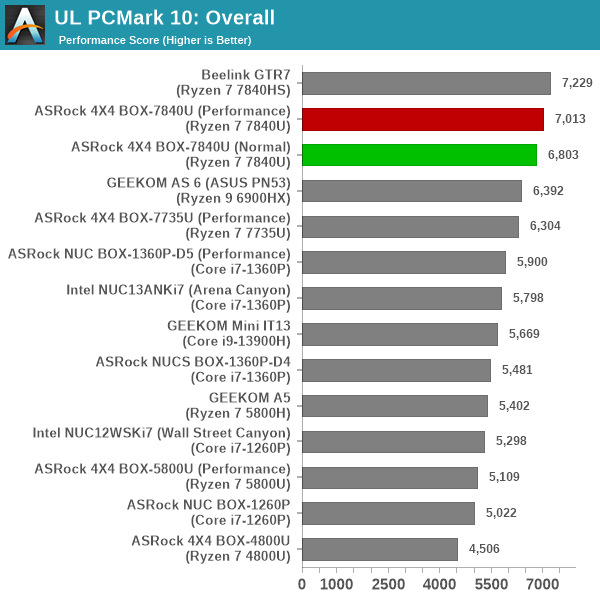
The Phoenix-based systems are on top across every segment, except for the 'Essentials' workload. On account of their multi-core / multi-threaded performance advantage and the iGPU capabilities, that is no surprise. The single-threaded performance is a little bit behind Intel's Raptor Lake, even when the power limit is bumped up to 65W, and that is evident in the Essentials score.
UL Procyon v2.1.544
PCMark 10 utilizes open-source software such as Libre Office and GIMP to evaluate system performance. However, many of their professional benchmark customers have been requesting evaluation with commonly-used commercial software such as Microsoft Office and Adobe applications. In order to serve their needs, UL introduced the Procyon benchmark in late 2020. There are five benchmark categories currently - Office Productivity, AI Inference, Battery Life, Photo Editing, and Video Editing. AI Inference benchmarks are available only for Android devices, while the battery life benchmark is applicable to Windows devices such as notebooks and tablets. We presents results from our processing of the other three benchmarks.
| UL Procyon - Office Productivity Scores | |||

The workloads involved in the 'Office Productivity' segment all benefit from single-threaded performance, and that is evident as the Raptor Lake-based systems all have a good lead over the Phoenix-based ones. At 65W, the GTR7 manages to inch closer to the 35W Core i9-13900H in the GEEKOM Mini IT13, but the Phoenix systems are a step behind irrespective of the power limits.
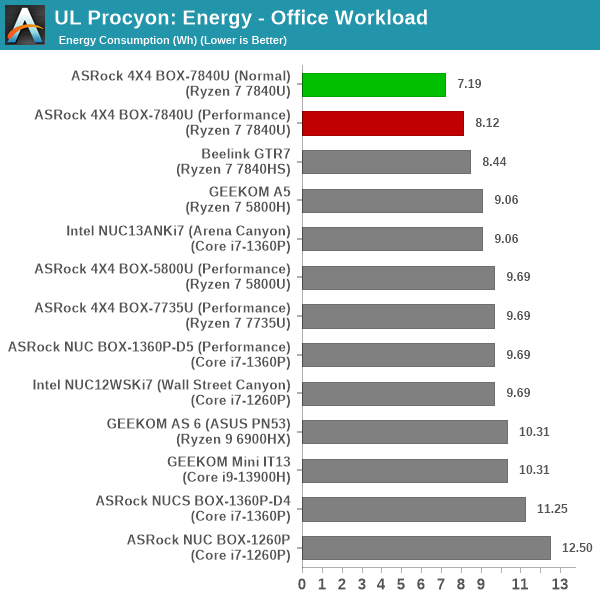
From an energy consumption viewpoint, the 4nm process for Phoenix seems to be working wonders, as the 4X4 BOX-7840U in its 28W avatar manages to complete the workload with minimal energy consumption. It might not be the fastest machine for the workload, but it is quite power efficient in getting the job done.
Moving on to the evaluation of Adobe Photoshop and Adobe Lightroom, we find that the multi-core performance and iGPU advantage helps the Phoenix systems lock up the top spots. Interestingly, there is not much difference between the 40W and 65W versions, and this points to the overdrive to 65W being of not much benefit.
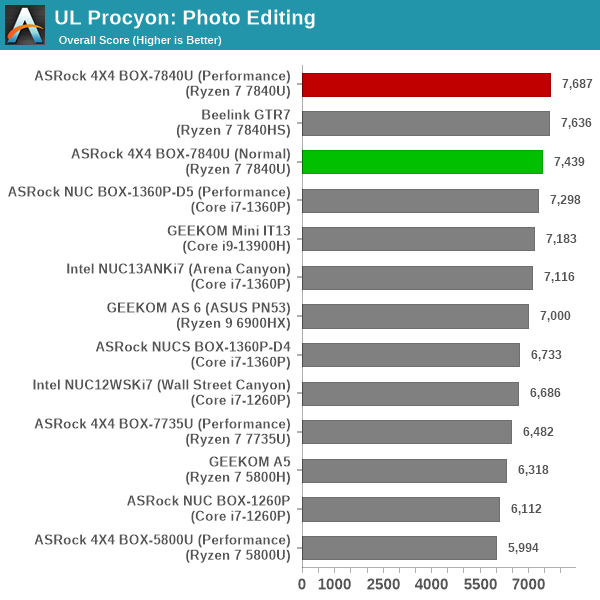
In fact, the energy consumption for the GTR7 is discernably more than the one for the 40W version of the 4X4 BOX-7840U, pointing to a sweet spot of around 35W for the processor to deliver a good performance / power efficiency balance.

UL Procyon evaluates performance for video editing using Adobe Premier Pro.
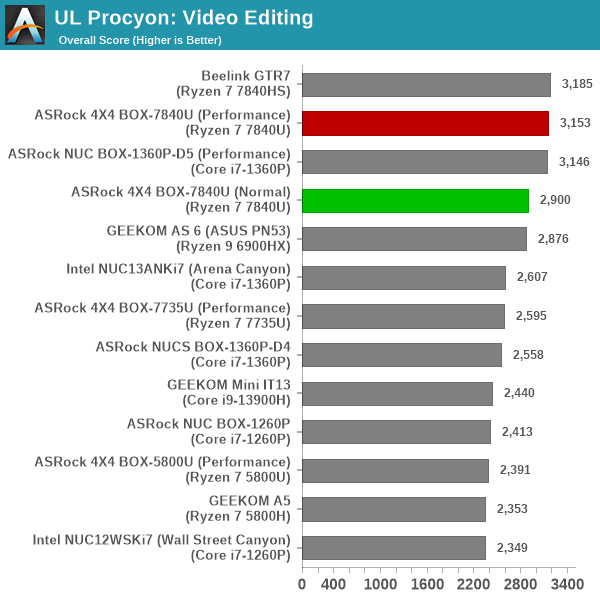
This workload appears to benefit from the extra power budget, and the 40W+ configurations of both Raptor Lake-P and Phoenix provide similar performance numbers.
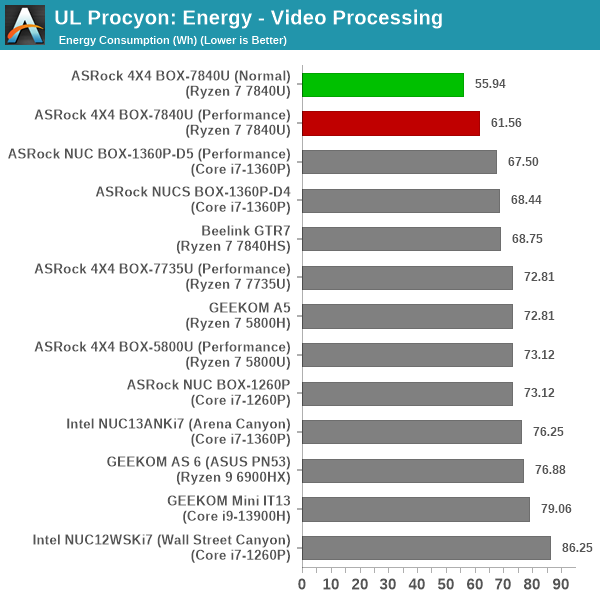
However, the 4X4 BOX-7840U configurations are the most energy efficient of the lot, with the 40W mode presenting a good balance between performance and energy consumption with the second place in both graphs.
BAPCo CrossMark 1.0.1.86
BAPCo's CrossMark aims to simplify benchmark processing while still delivering scores that roughly tally with SYSmark. The main advantage is the cross-platform nature of the tool - allowing it to be run on smartphones and tablets as well.
| BAPCo CrossMark 1.0.1.86 - Sub-Category Scores | |||
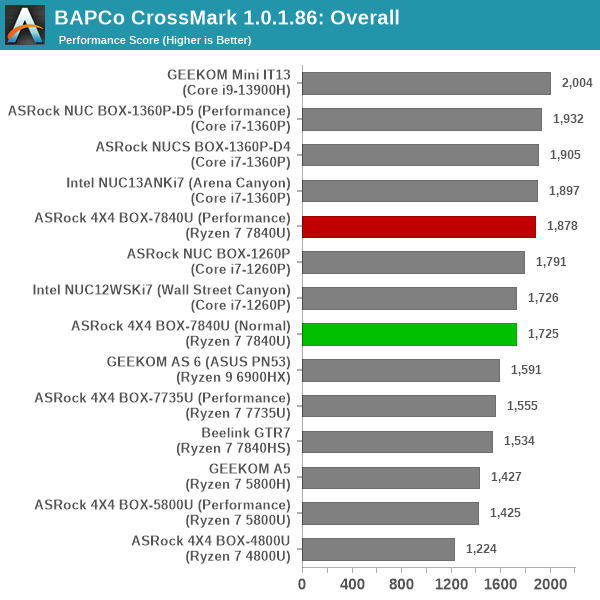
The use of idle time compression favors Intel-based systems, but that is not indicative of real-world performance. Based on these results, it would appear that scripting and automating workloads to keep the system busy all the time would probably be better on the Intel-based PCs. Since CrossMark attempts to consolidate different workloads together without idle time intervals and play it back in a non-real-time environment, it is not entirely representative of real-world performance like PCMark 10 and UL Procyon. Therefore, tasks requiring frequent user interaction are better represented by those other benchmarks.










13 Comments
View All Comments
FWhitTrampoline - Sunday, December 31, 2023 - link
Get an Intel Meteor Lake based system instead as that at least has the iGPU compute support ducks in order for Linux via Intel's OneAPI/Associated iGPU Compute API support. On Linux AMD's ROCm/HIP is not supported on AMD's current iGPUs and really that's going to limit any Ryzen APU based systems to Blender Cycles CPU only rendering whereas Intel's Meteor Lake will be able to utilize the iGPU for Blender 3D's GPU accelerated rendering. And even iGPUs have a bit more FP resources than CPUs and Intel's ARC Graphics tile has Ray Tracing units as well with a higher level of hardware feature support than AMD's RDNA3 Ray Tracing IP.haplo602 - Sunday, December 31, 2023 - link
so what is the advantage over a beelink/minisforum/morefine ? except the higher price ?TheinsanegamerN - Tuesday, January 2, 2024 - link
Better support and a website that works? Minisforum's site is held together with duct tape.